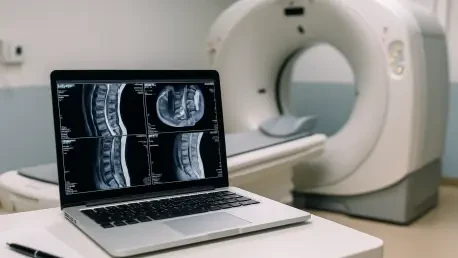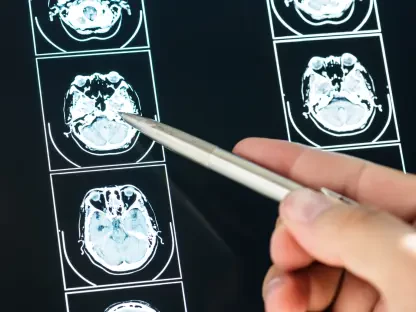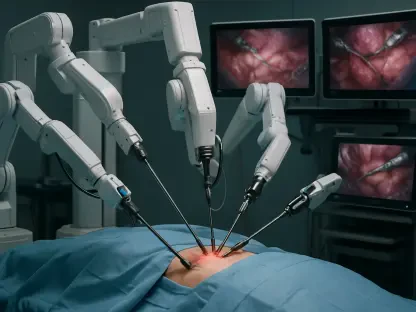Artificial intelligence (AI) stands at the forefront of a potential revolution in medical imaging, promising to reshape how healthcare professionals diagnose and treat patients with unprecedented accuracy and efficiency. Experts like Marissa Fayer, CEO of DeepLook Medical, have emphasized that the possibilities for AI in this field seem limitless, with no clear boundary to its innovative potential. From enhancing the clarity of scans to predicting long-term patient outcomes, the technology could redefine clinical practices. Yet, despite this immense potential and growing excitement, the journey toward widespread adoption in hospitals and clinics remains frustratingly slow. Significant barriers, rooted in infrastructure and systemic challenges, continue to hinder progress, leaving many to wonder why such a transformative tool struggles to gain traction. This exploration delves into the remarkable promise of AI in medical imaging while unpacking the stubborn obstacles that keep it from fully integrating into everyday healthcare.
Unlocking Endless Possibilities with AI
The unique strength of AI lies in its ability to process and interpret complex visual data, making it an ideal match for medical imaging applications. Current tools already assist clinicians by enhancing visualization and supporting critical decision-making processes during diagnostics. For instance, AI algorithms can highlight subtle anomalies in scans that might escape the human eye, thereby improving accuracy. Beyond these existing capabilities, industry leaders envision a future where AI takes on more independent roles, such as autonomously analyzing images without direct oversight. This could streamline workflows in radiology departments, allowing for faster and more precise results. The alignment of AI’s analytical prowess with the visual demands of medical imaging positions it as a game-changer, capable of pushing the boundaries of what’s possible in patient care. As research continues to evolve, the technology’s potential to transform diagnostics seems not just promising, but inevitable.
Looking further ahead, the scope of AI in medical imaging extends beyond immediate diagnostics to predictive and longitudinal analysis. Imagine a system that not only interprets a current scan but also forecasts a patient’s health trajectory based on historical data and trends. Such advancements could enable proactive interventions, potentially saving lives by identifying risks before they manifest into serious conditions. Market projections reinforce this optimism, with estimates from GlobalData suggesting the AI healthcare sector could reach a valuation of $19 billion by 2027. Significant investments in companies developing AI for radiology further signal strong confidence in its future impact. These financial commitments reflect a belief that AI will not only refine existing processes but also introduce entirely new approaches to healthcare. Yet, while the horizon looks bright, the path to realizing these ambitious goals remains fraught with challenges that temper the enthusiasm.
Confronting Infrastructural Roadblocks
Despite the clear potential, the integration of AI into medical imaging faces substantial hurdles, primarily due to outdated infrastructure in many healthcare systems. In high-income regions such as the United States, United Kingdom, and parts of Europe, legacy systems dominate the landscape, often lacking the compatibility needed to support cutting-edge AI tools. These older frameworks, built on technology from decades past, create a significant bottleneck, preventing seamless adoption of innovations that could enhance patient outcomes. Upgrading such systems is not a simple task; it involves substantial costs, time, and coordination across numerous stakeholders. As a result, many institutions remain stuck with inefficient processes, unable to fully harness AI’s capabilities. This infrastructural lag stands as a primary barrier, overshadowing other concerns and delaying the widespread implementation of promising technologies.
Beyond the technical challenges, there exists a cultural and organizational resistance within some medical communities that further complicates AI adoption. While the reluctance of certain practitioners to cede control to automated systems is often cited, experts argue this issue is secondary to the broader systemic limitations. The hesitation stems from valid concerns about reliability, accountability, and the ethical implications of machine-driven decisions in healthcare. However, the more pressing obstacle remains the inability of existing hospital infrastructures to accommodate rapid technological change. Without a concerted effort to modernize these foundational systems, even the most advanced AI solutions risk remaining confined to pilot studies and academic research, far from the real-world clinical settings where they are most needed. Addressing this gap requires not just investment, but a strategic overhaul of how healthcare facilities plan for and integrate new tools.
Global Disparities in AI Integration
A striking contrast emerges when examining the adoption of AI in medical imaging across different regions of the world, revealing unexpected trends. Lower- and middle-income countries are often outpacing their wealthier counterparts in implementing AI solutions within healthcare. Unencumbered by the burden of entrenched legacy systems, these regions have the advantage of building modern infrastructures from the ground up, with AI embedded as a core component. This flexibility allows for quicker integration of advanced technologies, enabling hospitals and clinics to bypass many of the obstacles faced by established systems in developed nations. Such a trend suggests that the global healthcare landscape could shift, with developing areas potentially leading the way in innovative practices. This disparity underscores the critical role that starting conditions play in technological advancement.
The implications of this global divide are profound, as they challenge traditional assumptions about where innovation typically thrives. In wealthier nations, the weight of historical investments in outdated technology slows progress, while less resourced regions seize the opportunity to leapfrog into modernity. This phenomenon highlights a unique window for developing countries to redefine healthcare delivery through AI, potentially setting new benchmarks for efficiency and accessibility. Meanwhile, high-income countries must grapple with the costly and complex task of retrofitting or replacing their existing systems to keep pace. The disparity serves as a reminder that innovation is not solely a matter of financial capacity, but also of adaptability and strategic foresight. As this trend unfolds, it could reshape how the international community approaches the dissemination and implementation of healthcare technologies.
Navigating the Path Forward
The story of AI in medical imaging is one of striking duality—immense promise tempered by persistent challenges that demand urgent attention. On one side, the technology’s capacity to revolutionize diagnostics and improve patient care is undeniable, supported by robust market growth and expert consensus on its transformative potential. The ability to enhance precision and predict outcomes positions AI as a cornerstone of future healthcare advancements. On the other side, systemic barriers, particularly in developed nations with outdated infrastructures, continue to impede progress, creating a frustrating gap between vision and reality. This tension reveals a critical need for strategic solutions that prioritize modernization and adaptability in healthcare systems worldwide.
Reflecting on past efforts, it becomes evident that overcoming these obstacles requires more than just technological innovation; it demands a rethinking of how healthcare infrastructures are designed and updated. Looking ahead, actionable steps emerge as essential, such as targeted investments in upgrading legacy systems and fostering international collaboration to share best practices from regions with faster adoption rates. Policymakers and industry leaders need to focus on creating flexible frameworks that can accommodate rapid advancements while addressing ethical and practical concerns. By learning from the agility of developing nations, established systems can chart a clearer path toward integration. These considerations offer hope that the remarkable potential of AI in medical imaging will eventually translate into tangible benefits for patients everywhere.









